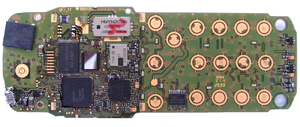
- Image via Wikipedia
The Economist recently published an excellent survey of the growing world of sensors, noting in particular the use of sensors in mobile phones. It’s worth considering what this will mean for publishing. Since smartphones are a relatively new development, sensor publishing built around mobile phones is a new area, which makes it a prime prospect for growth.
Sensors can pick up many kinds of information (temperature, altitude, geographical location, radiation, etc.), and we should anticipate that over time sensors will be developed for any aspect of the physical universe. And maybe the social universe, too — we can too easily imagine the Big Brother app, which sits on your mobile phone and picks up all the ambient sounds including conversations.
For some sensors, the phone’s owner may direct the inputs, as when someone uses a phone as a bar-code reader, but other sensors will operate autonomously — How fast is this car traveling? What is the humidity? What patterns can be detected (and what do they mean) when a phone’s ringer is turned on and off? All the data that is collected is then sent over the network to a database, where it is (or will be) analyzed in many ways. The output of that analysis could be a publishing product.
I first stumbled across the role of sensors several years ago, when an entrepreneur pitched his new company to me. His idea was to affix sensors to fleets of trucks and collect data from these mobile sources. I will decline to say what he planned to do with the data (yes, it was an eye-popper), but it was a publishing idea — high-end analytic data delivered to a specialized market. (For some reason, he seemed to believe I was the right person to introduce him to all the nation’s fleet operators.)
The idea of using cars and trucks is not all that far-fetched. I see that the U.S. Postal Service is looking to open a badly needed new revenue stream by licensing its fleet of trucks to sensor operators and data-gathering companies. (The USPS report is a PDF buried on the site at http://www.prc.gov, but more easily found by Googling “Offering Sensor Network Services Using the Postal Delivery Vehicle Fleet.”) Of course, no fleet of trucks can provide what mobile phones can, as we carry our phones with us everywhere. They monitor us and our experience at every moment. We are the data.
Sensor publishing is the opposite of face-down publishing. Face-down publishing has at its center the interface between a human and a mobile phone, which is viewed face-down. The data displayed on that phone is likely to be sifted by a sophisticated series of back-end processes, but the defining characteristic of the paradigm is to deliver content to the mobile user. With sensor publishing, the people who carry mobile phones are essentially hosts, a necessary and convenient means to get sensors into the environment. For sensor publishing, the mobile phone is an input; for face-down publishing, the mobile phone is the platform for the output.
Of course, a service can be both sensor-based and face-down at the same time. For instance, information that a phone picks up from its host (say, body temperature) can be sent to the back-end data-processing center, analyzed and interpreted, and then returned to the user’s phone as part of a personal health report.
Sensor publishing should not be confused with crowdsourcing. In crowdsourcing, a number of people contribute bits of content that is then aggregated into a final product or service. Wikepedia is crowdsourced, as is Project FeederWatch at Cornell University, where individuals set up a bird feeder near their homes which transmits information about bird behavior. We had crowdsourcing before we had a name for it: the Zagat restaurant guides, for example, and the management of the Dewey Decimal system, in which various librarians catalog books and send their records to OCLC.
Sensor publishing differs from crowdsourcing in that it lacks human agency. Humans carry the phones with the embedded sensors, but they do not operate the sensors; the sensors are not dependent on the conscious inputs of their hosts. Think of sensors as being like the DNA in our bodies. Our relationship with our DNA is fundamental, but we do not command it; we carry it.
The customers for sensor publishing will vary with the kind of data collected and the analytic tools brought to bear on it. Personal health reports are an obvious form of publication in which we will subscribe to services that monitor our health and behavior through our phones. At Purdue, researchers have come up with radiation detectors that would turn mobile phones into nodes of an early warning system for terrorist attacks; presumably the customers for such information will be governmental agencies. Thanks to GPS, sensors can also detect which are the hot restaurants in a given neighborhood and how quickly traffic is moving during rush hour (and where to route subscribers for a faster route). Santa Claus will subscribe to the service that knows when you are sleeping and when you are awake, and your insurance company will pay a hefty amount for information about how frequently you step into a ribs joint or purchase cigarettes by charging them on your mobile phone.
But some of these examples are whimsical and trivial. More to the point are the applications that study the inputs from huge populations, with each and every input linked to a human being. Zoologists have electronic tags to track wildlife, and we will have our phones, the devices that more than any other form an intimate attachment to the people whose lives increasingly revolve around them. Creative publishers will identify useful forms of data to gather, analyze it carefully, and package it for new classes of customers. Some of those customers will be consumers, but at least at the early stages of sensor publishing, it is more likely that information products will be marketed to government and industry.
Note the absence of an author in sensor publishing, unless the designer of the analytic algorithms can be said to be an author. It’s often said that the Internet disintermediates publishers, but many future publishing applications seem to disintermediate authors instead.
Designing sensor publishing products and bringing them to market will be no easy task. What information do you want to gather? Can you truly add value by aggregating it — or will this simply be another instance of a massive but largely useless data dump? Can you actually get people or organizations to pay for these things? Let’s call these the publishing problems; while they look a bit different in the sensor world, they concern questions that are familiar to anyone who has ever published an article on chemistry, an anthropology textbook, or a novel.
On top of these problems, however, are the complications of getting access to the data — that is, access to the mobile phones and the datastreams they engender. Here the mobile carriers will play a role, and not always a welcome one. They will control the design of the hardware (“We don’t want your sensor on our phone”) and impose limitations on the kinds of software to install. Just as Comcast in the cable world wants to control much of the content that flows through its service, wireless carriers will want to play a role, perhaps a dominant one, in this publishing flow. For this reason some publishers will attempt to forge relationships with the carriers, but it remains to be seen who will get the better of such arrangements.
I drafted this post after sitting through a conference call that focused on costs, cost reductions, shrinkage, and fear. I am myself struck more by the prospects for growth. But growth won’t take place where it took place before. There is little opportunity in creating the next New Yorker or a distinguished medical journal, the new Lancet, to be marketed to academic libraries. Publishers seeking growth should look to the new platforms, study their peculiar properties, and experiment with new programs built upon them.
Discussion
5 Thoughts on "The Ambient Authorship and Subtle Potential of Sensor Publishing"
There may be a parallel here with what librarians are discussing with regard to data curation. Librarians are feeling an increasing responsibility to move the process of curation upstream to the raw data. This does not involve an automatic process, of course, as sensors do, but it does challenge librarians to think about their roles in new ways, just as sensors will challenge publishers to reconceive what it is they do. What “value added” can traditional publishers bring to the data dumping that the proliferation of sensor devices will bring? Surely, they will be more than just passive conveyors of the data?
Interesting post, Joe.
I wonder if partnerships between data consumers (government or business) and mobile phone carriers will lead to deeply discounted phones and plans in return for the user allowing unfettered data collection.
In other words, those who don’t care or fear Big Brother will be offered a (sensor-equipped) phone much more cheaply than those who resist being used as data collectors.
It would be similar to paying a higher price to watch an on-demand movie without commercials versus paying nothing but enduring advertisements.



